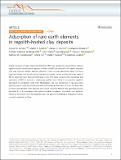Files in this item
Adsorption of rare earth elements in regolith-hosted clay deposits
Item metadata
| dc.contributor.author | Borst, Anouk Margaretha | |
| dc.contributor.author | Smith, Martin P. | |
| dc.contributor.author | Finch, Adrian A. | |
| dc.contributor.author | Estrade, Guillaume | |
| dc.contributor.author | Villanova-de-Benavent, Cristina | |
| dc.contributor.author | Nason, Peter | |
| dc.contributor.author | Marquis, Eva | |
| dc.contributor.author | Horsburgh, Nicola J. | |
| dc.contributor.author | Goodenough, Kathryn M. | |
| dc.contributor.author | Xu, Cheng | |
| dc.contributor.author | Kynický, Jindřich | |
| dc.contributor.author | Geraki, Kalotina | |
| dc.date.accessioned | 2020-09-07T11:30:07Z | |
| dc.date.available | 2020-09-07T11:30:07Z | |
| dc.date.issued | 2020-09-01 | |
| dc.identifier | 269100320 | |
| dc.identifier | 41a90d72-6343-4f9f-80e5-eed56c1893ab | |
| dc.identifier | 85090055421 | |
| dc.identifier | 000569891500013 | |
| dc.identifier.citation | Borst , A M , Smith , M P , Finch , A A , Estrade , G , Villanova-de-Benavent , C , Nason , P , Marquis , E , Horsburgh , N J , Goodenough , K M , Xu , C , Kynický , J & Geraki , K 2020 , ' Adsorption of rare earth elements in regolith-hosted clay deposits ' , Nature Communications , vol. 11 , 4386 . https://doi.org/10.1038/s41467-020-17801-5 | en |
| dc.identifier.issn | 2041-1723 | |
| dc.identifier.other | ORCID: /0000-0002-3689-1517/work/80257335 | |
| dc.identifier.other | ORCID: /0000-0003-4553-9037/work/80257869 | |
| dc.identifier.other | ORCID: /0000-0003-0775-1491/work/80257904 | |
| dc.identifier.uri | https://hdl.handle.net/10023/20575 | |
| dc.description | Funding: UK NERC SOSRARE consortium, grant numbers NE/M010856/1 (to AMB, AAF and NJH), NE/M011267/1 (to MS, GE, PN, CVdB and EM) and NE/M01116X/1 (to KMG). JK was supported by The Czech Science Foundation GACR EXPRO (grant number 19-29124X). Diamond Light Source I18 beam time awards (grant numbers SP14793 and SP15903). | en |
| dc.description.abstract | Global resources of heavy Rare Earth Elements (REE) are dominantly sourced from Chinese regolith-hosted ion-adsorption deposits in which the REE are inferred to be weakly adsorbed onto clay minerals. Similar deposits elsewhere might provide alternative supply for these high-tech metals, but the adsorption mechanisms remain unclear and the adsorbed state of REE to clays has never been demonstrated in situ. This study compares the mineralogy and speciation of REE in economic weathering profiles from China to prospective regoliths developed on peralkaline rocks from Madagascar. We use synchrotron X-ray absorption spectroscopy to study the distribution and local bonding environment of Y and Nd, as proxies for heavy and light REE, in the deposits. Our results show that REE are truly adsorbed as easily leachable 8- to 9-coordinated outer-sphere hydrated complexes, dominantly onto kaolinite. Hence, at the atomic level, the Malagasy clays are genuine mineralogical analogues to those currently exploited in China. | |
| dc.format.extent | 15 | |
| dc.format.extent | 4733421 | |
| dc.language.iso | eng | |
| dc.relation.ispartof | Nature Communications | en |
| dc.subject | GE Environmental Sciences | en |
| dc.subject | QE Geology | en |
| dc.subject | DAS | en |
| dc.subject | BDC | en |
| dc.subject | R2C | en |
| dc.subject.lcc | GE | en |
| dc.subject.lcc | QE | en |
| dc.title | Adsorption of rare earth elements in regolith-hosted clay deposits | en |
| dc.type | Journal article | en |
| dc.contributor.sponsor | NERC | en |
| dc.contributor.institution | University of St Andrews. School of Earth & Environmental Sciences | en |
| dc.identifier.doi | https://doi.org/10.1038/s41467-020-17801-5 | |
| dc.description.status | Peer reviewed | en |
| dc.identifier.grantnumber | NE/M010856/1 | en |
This item appears in the following Collection(s)
Items in the St Andrews Research Repository are protected by copyright, with all rights reserved, unless otherwise indicated.

